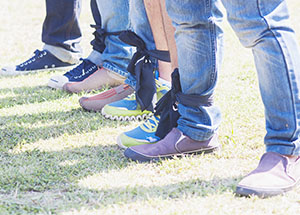Are You Hobbling or Helping Yourself?
By Jalene Case
Remember the three-legged race popular at family reunions and field days? Racers pair up and stand side-by-side with their arms around each other. Then the two touching legs are bound together and the hobbled racers do their best to dash straight ahead to the finish line! It doesn’t take much for them to tumble over into a giggling heap.
Are your thoughts, feelings, and actions helping you move toward what’s most meaningful to you? Or are they hobbling you, causing you to stumble and perhaps fall just short of your goals?
It’s easy to unconsciously create devices that cause us to flounder and fall. The invisible rope we unintentionally tie around our legs makes it tougher (and a lot less fun!) for us to get anywhere. Recently, I’ve started noticing how I manufacture my own pesky hobbling devices.
I thought about the way I cause my body unnecessary hardship by waiting way too long to step away from the keyboard and stretch. The muscles in my neck, shoulders, and upper back form a Union, striking as one big knot of tension in a desperate attempt to get my attention, pleading with me to stretch them back into fully functional human form.
I also noticed the way I manufacture unhelpful, fearful feelings in my mind long before I begin a project. You know that sinking sensation we can get before stepping out of our comfort zones and taking on a new challenge? We can’t believe we said yes and wonder if we’re up for it. It might sound something like this:
“You’re not a writer/leader/speaker, so why do you think you can pull this off?”
“You’re not smart/experienced/creative enough.”
I even thought back to a time when I limited myself, working too long at a job that did not fit my strengths and passions. I tangled myself up with desk-ridden, rule-laden tasks when inside, my heart’s voice whispered my desire to be connecting more with people.
Seeing our own hobbling devices is tricky because we often aren’t aware that we’re doing it to ourselves. A coach, mentor, or friend’s insight can help us uncover what’s causing our stumbles. Once we see our concealed creations, we can dismantle them.
Dismantling Your Hobbling Devices
Body Comfort
Most of us these days are laboring over a computer keyboard and struggling to do it in a way that doesn’t cause too much discomfort.
In response to my knotted-up neck and shoulders, a clever massage therapist told me, “Jalene, Jalene, stretch your scalene!” You can feel your scalene muscles right now, along the side of your neck, if you tilt your ear toward your shoulder.
Here’s a simple stretch: Stand up. With your arms resting straight by the side of your body, gently lean your ear sideways toward your right shoulder, and hold. If you want more of a stretch, bend your left arm so your wrist is behind your lower back. Go gentle and slow. Listen to your body. Switch sides.
Experiment with ways to increase the comfort level of your body.
Inner Operating System
Our inner operating system is how I think of what we say to ourselves on the inside. We’re usually not aware of it, similar to the OS in our technology devices. An inner sound track loops with words, phrases, and sentences that have the power to take us down, or build us up. Pay attention to what you’re saying to yourself. Is it helping or hobbling you?
That hurtful, critical voice can be a gremlin or saboteur. A common reaction to that voice is to do battle with it, to convince it that it’s not right. That’s wrong. Rick Carson’s book, Taming Your Gremlin, implores people to simply notice. In doing this, Carson says that it taps into an age-old change process often called The Zen Theory of Change: “I free myself not by trying to be free, but by simply noticing how I am imprisoning myself in the very moment I am imprisoning myself.”
Listen to what you’re saying to yourself on the inside, and simply notice.
Draining vs. Energizing
Since we’re often unaware of the hobbling devices we’re building, it’s tough to know where they’re hiding out. The Emotional Intelligence skill of self-awareness can help us find them.
Pay attention to when you feel unreasonably drained, exhausted, or wiped out and, conversely, when you feel energized, excited, or invigorated. Begin making two lists. One for what drains you and one for what energizes you. Don’t be surprised if some things that energized you in the past are now draining you.
You can start by making your lists now. However, I encourage you to continue adding to them over a couple of weeks to see the whole picture.
Take a look at what’s draining you. Are there any hobbling devices there? What might you think, feel, or do to help yourself? What can you let go of doing?
Now, look at what energizes you. Are there any hobbling devices there? What might you think, feel, or do to help yourself? Consider each of these fabulous items. What does it bring you? How can you do more of it?
Holding ourselves back with invisible hobbling devices serves no one—not us or the people in our lives. Break free! By simply noticing, when and where we are tying ourselves up, we can see the devices we’ve created, dismantle them, and free ourselves.


